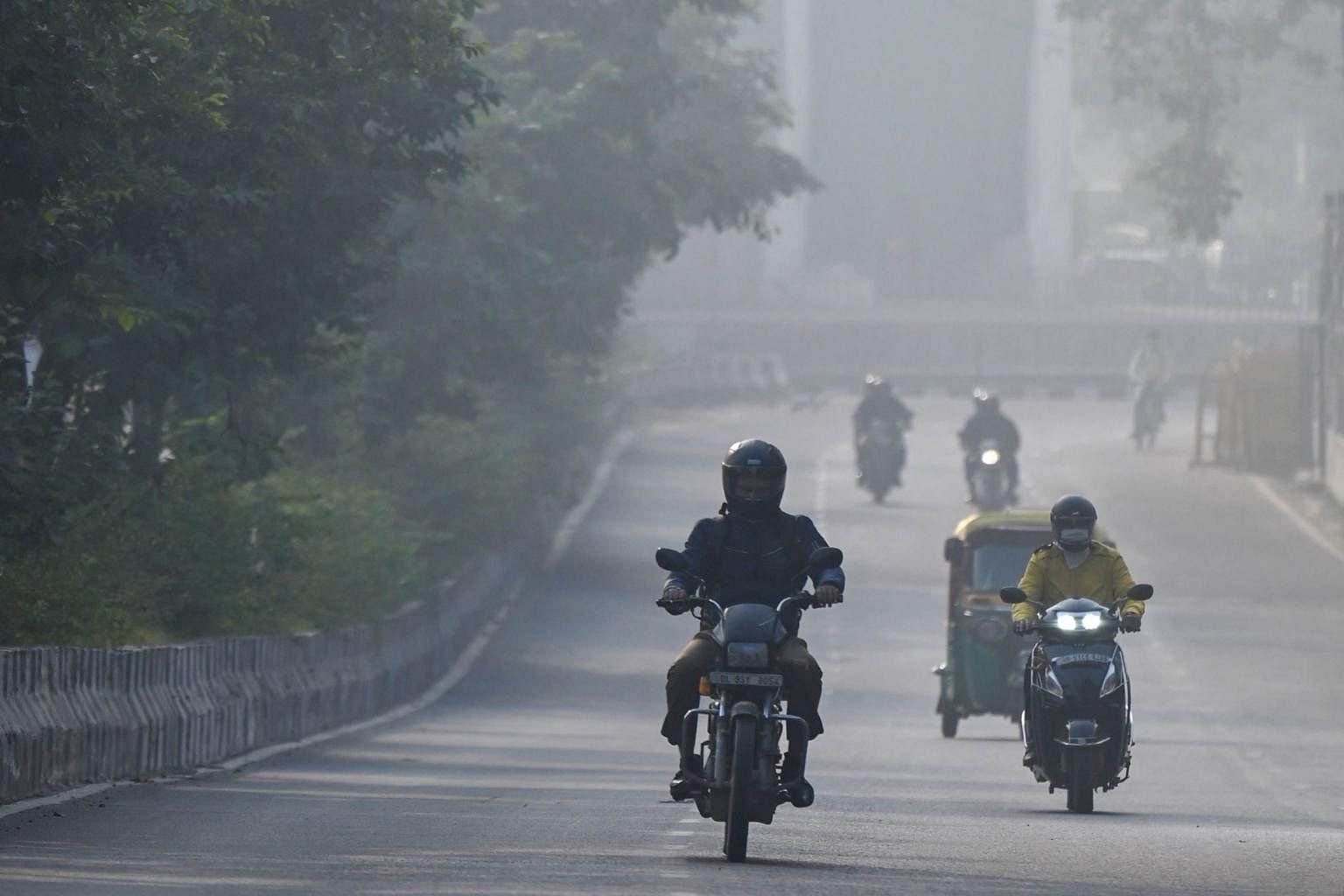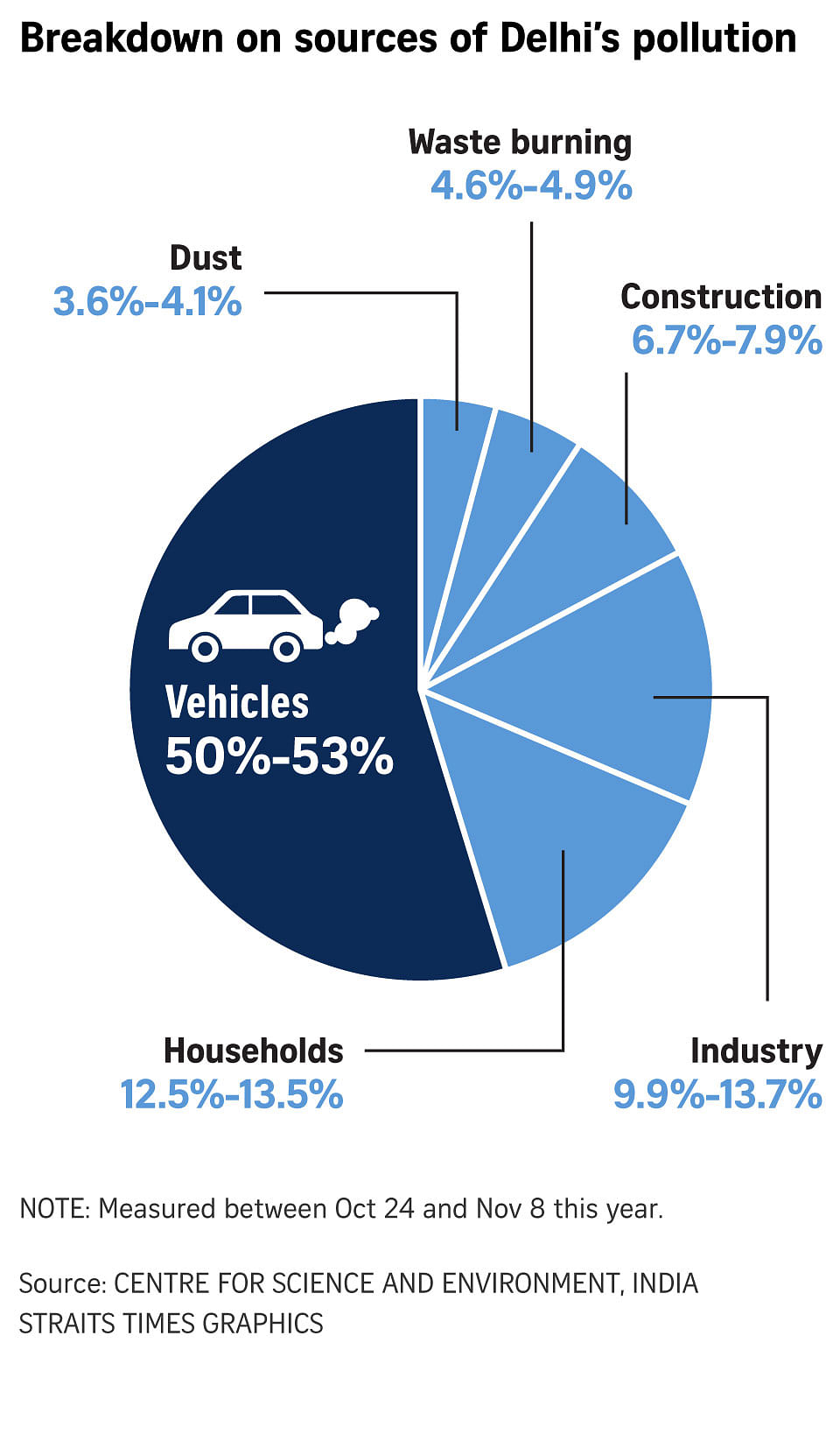India's top court orders 'work from home' over pollution in capital
Sign up now: Get ST's newsletters delivered to your inbox

New Delhi has been battling a toxic haze since early November.
PHOTO: AFP
Follow topic:
NEW DELHI - India's highest court on Monday (Nov 15) ordered millions of workers in New Delhi and nearby cities to work from home to reduce pollution coming from vehicle exhaust pipes, as air quality in the national capital region remains at hazardous levels.
This followed emergency measures taken on Saturday, with the ordered closure of schools and stopping of construction work for four days.
At the Supreme Court on Monday, Chief Justice N.V. Ramana, who heads a panel of three judges, took action in considering a petition by a city resident.
"We direct the centre and states of the national capital region to impose work from home for the meantime," he said.
The Supreme Court also asked for action to curb crop waste fires from states neighbouring Delhi - Haryana, Punjab and Uttar Pradesh. These annual fires are started by thousands of farmers who burn stubble to clear their fields quickly for the next planting season.
Experts said India's pollution problem remained intense with any event like adverse weather conditions, stubble burning for Delhi or the bursting of firecrackers all proving to be a tipping point leading to Air Quality Index becoming hazardous.
"Pollution peak will depend on year-round action to reduce pollution," said Ms Anumita Roy Chowdhury, executive director of Centre for Science and Environment (CSE), a green group.
An analysis by CSE of Delhi's air pollution found vehicular pollution contributed to half of the pollution. The city has 10.32 million registered cars.
Other factors included burning of waste, industrial pollution and burning of stubble by farmers to clear the air.
"Overall annual average of PM2.5 is coming down in Delhi. It's not going up anymore. But even after the decline, the levels are still high. We need to do more to meet the standard for PM2.5," said Ms Chowdhury.
PM2.5 is very fine particulate matter measuring 2.5 microns or less in diameter, and is linked to chronic bronchitis, lung cancer and heart diseases.
Air pollution is not a problem for the capital city alone. Other major cities such as Mumbai and Kolkata have also made it to the most polluted cities' lists.

Commuters make their way along a street amid heavy smoggy conditions in New Delhi on Nov 15, 2021.
PHOTO: AFP
Across India, increasing vehicular traffic, the burning of waste, polluting industrial units and open wood fires are the main causes for pollution.
Experts said lack of coordination among the authorities at different levels is one factor.
"The improvement in air quality is very slow over past years and the primary reason for that is the lack of coordination among various stakeholders," said Mr Sunil Dahiya, an analyst with the Centre for Research on Energy and Clean Air. "Be it the issue of reducing stubble burning or installing pollution control technology by coal-based power plants, various stakeholders have failed in implementing the real solutions on the ground."
He noted that there were also steps that had led to positive results and improved air quality like decisions to shift vehicles to BS VI, or Bharat Stage Emission Standards. It sets the permissible emission standard for pollutants that can be emitted, with petrol vehicles under BS VI required to reduce by 25 per cent their nitrogen oxide emissions.
There has also been a shift for industries to use gas instead of coke, a black-coal waste. Brick kilns are also shifting to use zigzag technology, which creates a zigzag air flow push, improving the heat transfer from the gases to the bricks.
Other initiatives include the Pradhan Mantri Ujjwala Yojana, which provides free liquefied petroleum gas (LPG) to households to stop the burning of solid fuels such as firewood.
There are 280 million LPG connections as of Feb 1 this year.
The government has been pouring financial resources to reduce air pollution since the National Clean Air Programme was launched in 2019.
Finance Minister Nirmala Sitharaman allocated 22.17 billion rupees (S$402 million) for 42 cities with over a million population for 2019, and two billion rupees for Delhi this budget.
But environmentalists said there is little clarity on how these plans are going and where cities are in terms of implementation.
"One of the key issues is the lack of stringent implementation of current legislations to control air pollution," said Dr Pallav Purohit, a senior research scholar at the Energy, Climate and Environment Programme of the International Institute for Applied Systems Analysis in Austria.
"After 2015, the Indian government has issued a wide range of pollution control policies and regulations. Their actual benefits on air quality will critically depend on the effectiveness of implementation and enforcement," he added.
One good thing that has emerged from the continued focus on the problem is higher public awareness of air pollution in the past few years.
Pollution has entered the country's consciousness after years of neglect as levels touched hazardous levels, impacting the health of metro residents, particularly children, with political parties promising clean air.
But the outrage, critical for strong political will, mostly dies down after pollution levels go down every year. Dr Purohit noted: "Policies with stronger political support are generally more successful in implementation."
The higher public awareness of the problem has, in the meantime, played out in a funny way, as frustrated citizens share pollution jokes on social media platforms.
South Delhi locality Hauz Khas was renamed Haze Khas, while old Delhi locality Chandni Chowk was renamed Chandni Choke.
Another widely distributed joke said: "Breathlessness. Palpitation. Moist eyes. You're either in love or in Delhi."


